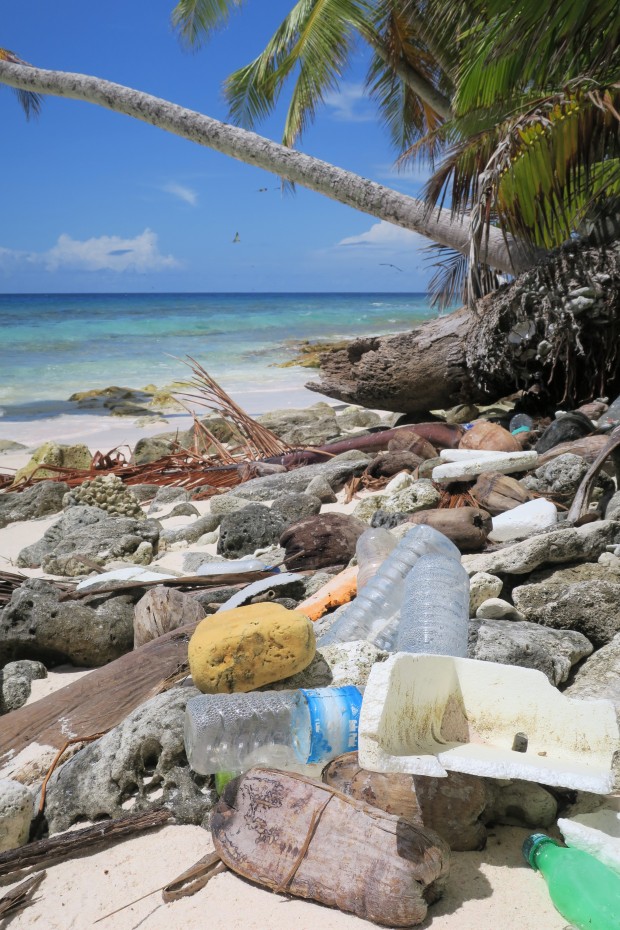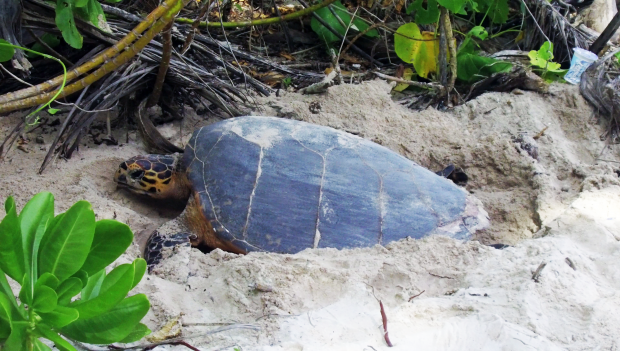Plastic pollution in the Chagos Archipelago
Earlier this year the Zoological Society of London was awarded a Darwin Initiative grant to better understanding how plastics affect the natural environment in the Chagos Archipelago. Rachel Jones, ZSL and CCT trustee, explains why this is so important.

With less than 10% recycled to date and resisting degradation for decades, most of the billions of tonnes of plastic ever produced still exists somewhere in the world, much of it in the ocean.
A short walk along a beach in the Chagos Archipelago is all that is needed to see evidence of this problem piled up—and it’s a disturbing sight.
These islands are some of the most remote in the Indian Ocean; the next nearest land mass is Addu atoll in the Maldives 500km away. However, if you look at the whole Indian
Ocean basin you’ll see a largely enclosed sea ringed by growing human populations along the coastlines from East Africa to South East Asia.
Ocean currents driven by monsoonal winds can bring floating debris from all over the Indian Ocean to the beaches of the archipelago—in oceanographic terms they are at the centre of a perfect storm of plastic.
Plastic debris collecting on beaches is particularly significant for sea turtles. The British Indian Ocean Territory Marine Protected Area has regionally significant populations of both green turtle (Endangered) and hawksbill turtle (Critically Endangered).
Long stretches of the island’s beaches are studded with depressions called ‘body pits’ left by nesting females coming ashore to lay their eggs. However plastic waste in and on the sand can impede the females from excavating the deep holes they need to dig for their nests, sometimes causing them to give up.
While the eggs are developing in the nest, temperature plays a key role in determining the number of male and female hatchlings.
 Too hot and the hatchlings can become overwhelmingly female, an increasingly common problem for turtles in today’s warming world.
Too hot and the hatchlings can become overwhelmingly female, an increasingly common problem for turtles in today’s warming world.
Microplastics in the sand column can conduct heat faster than the surrounding sand and may be changing the conditions in ways that skew hatchling sex ratios.
Beach plastic also accumulates in the body pit over the nest and when hatchlings emerge six weeks after the eggs were laid, they are immediately faced with a pile of waste between them and the sea.
Turtles may also ingest plastic when foraging and can even become entangled in plastic in the water. All of these things mean that for an aquatic, air-breathing animal dependent on clean beaches, plastics are a significant environmental hazard at several points in the sea turtle’s life history.
For all these reasons, better understanding how plastics affect the natural environment in the Chagos Archipelago is one of the key objectives of a new three-year project partnering the British Indian Ocean Territory administration with Swansea University and the Zoological Society of London, funded by the Darwin Plus fund from DEFRA.
The team will study the ways in which plastics interact with turtles and identify mitigations to minimise the negative impacts.
They will record and categorise the plastics washing up on beaches and recruit volunteer help to clear the beaches to coincide with the turtles’ nesting seasons.
The final part of the puzzle is what to do with plastics that are collected when you are a long way away from the nearest recycling centre.
Over the course of the project the team will assess new technologies in the reuse and recycling of waste plastics, and look for ways to make them work in the challenging environment of the Chagos Archipelago.
Images (c) Dan Bayley and ZSL

